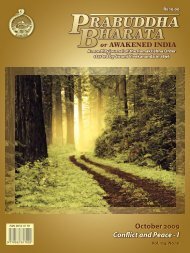October 2011 - Advaita Ashrama
October 2011 - Advaita Ashrama
October 2011 - Advaita Ashrama
You also want an ePaper? Increase the reach of your titles
YUMPU automatically turns print PDFs into web optimized ePapers that Google loves.
Religious Pluralism and<br />
Inter-religious Dialogue<br />
Prof. Dilipkumar Mohanta<br />
Sarvepalli Radhakrishnan calls<br />
Swami Vivekananda a ‘spokesman of the<br />
Divine Logos’.1 And Swamiji, true to his<br />
nature and also to the spirit of India’s pluralistic<br />
cultural history, says that different religions ‘are<br />
different forces in the economy of God, working<br />
for the good of mankind; and not one can<br />
become dead, not one can be killed.’2 Moreover,<br />
this truth was demonstrated by his guru<br />
Sri Ramakrishna, who said: ‘Yatho mat, tatho<br />
path; as many opinions, so many paths.’ Elaborating<br />
on this saying Sri Ramakrishna said: ‘If<br />
you believe that God is formless, then stick to<br />
that belief with firm conviction. But don’t be<br />
dogmatic; never say emphatically about God<br />
that He can be only this and not that. You<br />
may say: “I believe that God is formless. But<br />
He can be many things more. He alone knows<br />
what else He can be. I do not know; I do not<br />
understand.” ’ 3<br />
Given the diversity of human nature and<br />
temperament, the uniqueness of each religious<br />
tradition is essential for its existence. When<br />
Swamiji speaks of unity in the context of religions,<br />
he does not speak of uniformity. This<br />
unity lies at the core of all religions. His thorough<br />
reading of India’s cultural history enables<br />
him to decipher the cultural semiotics<br />
that reveals the open, free, and potentially creative<br />
pluralistic Indian mind. Defending the<br />
pluralistic approach Swamiji says: ‘There may<br />
be almost contradictory points of view of the<br />
same thing, but they will all indicate the same<br />
638<br />
thing.’ 4 This may be considered as an important<br />
clue to understand religious pluralism and to<br />
initiate inter-religious dialogue; but each religious<br />
tradition, according to Swamiji, contains<br />
within itself a special evolutionary pattern. This<br />
implies that religious traditions, as different<br />
ways of life, are shaped by sociocultural contexts;<br />
and as sociocultural contexts are in flux,<br />
religious traditions also undergo change. If any<br />
religion resists change, it creates rigidity and<br />
advocates exclusivism. Swamiji remarks that religions<br />
‘become dangerous only when they become<br />
rigid, and will not move further’ (2.500).<br />
Unless a minimal condition of openness and<br />
receptivity is fulfilled no inter-religious dialogue<br />
can be initiated, for such a dialogue must<br />
allow us to question and disagree with sincerity<br />
and respect. It surely does not stop with the<br />
practice of tolerance of other faiths, but it has<br />
to accept other religions as true. The pluralistic<br />
hypothesis about religion relativizes one’s<br />
own religion by situating it within the broader<br />
context of religious plurality. It indicates a direct<br />
experience of ‘otherness’, which is difficult<br />
to ignore in today’s world. This feeling or, to<br />
use a Paul Tillich’s phraseology, ‘ultimate concern’<br />
is the essential feature of any true religion<br />
for the age, which has to teach the sacrifice of<br />
one’s personal interests for a common good and<br />
the sensibility to feel on a par with others. It<br />
is sad that in many institutionalized religions<br />
very few people have the attitude of accepting<br />
others’ faiths as true as their own.<br />
PB <strong>October</strong> <strong>2011</strong>

















